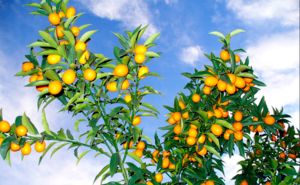
Kumquat (Fortunella japonica; F. crassifolia; F. margarita) is an evergreen shrub or small tree that bears fruit that have the appearance of miniature oranges. The term kumquat may also be spelled "cumquat", both spellings are correct, depending on which part of the world you hail from. The tree originated in China.
Despite having the appearance of an orange, this tree is only distantly related to orange trees. It is a compact bush or tree, that remains small, so it is a good choice for small garden areas, where it can add colour and provide an edible fruit. The root system is non-invasive and remains shallow.
This plant can be grown across a wide range of climates.
Description[edit | edit source]
It is an evergreen bush or small tree. There are three varieties of kumquat, the Marumi (round), the Nagami (oval) and the Meiwa (sweeter).
The leaves can be either a green or variegated. They form a dense foliage.
The fruits grow with a yellow colour, which turns to a deep orange colour when the fruit is ripe for harvesting. The fruits are usually no more than 2.5cm in size.
Growing kumquats[edit | edit source]
Choose a suitable climate zone. Kumquats can handle climates from the cool to tropical zones, so they are fairly handy for many garden types. They prefer a warm, sunny placement.
Plant grafted potted plants for the best success.
Plant in the winter. Choose soil that is fertile and well drained, either in a large container or directly into the ground.
Kumquat trees will tolerate frost.
Fertilise in the late spring. It can be fertilised again in either later summer or early autumn.
Expect to harvest the first fruit about two years after planting.
Uses for kumquats (as a fruit)[edit | edit source]
Kumquats tend to quite sharp or bitter, and are not to everyone's liking. Most people prefer the fruit when it has been turned into marmalade, chutney or pickles.
If you do wish to eat the fruits, they can be eaten with the skin on, just be sure to wash them first. Choose the Meiwa variety for sweeter, less sour fruit for eating. It usually has fewer or no seeds as well.
The fruits can also be added to sauces or as a garnish for some dishes.